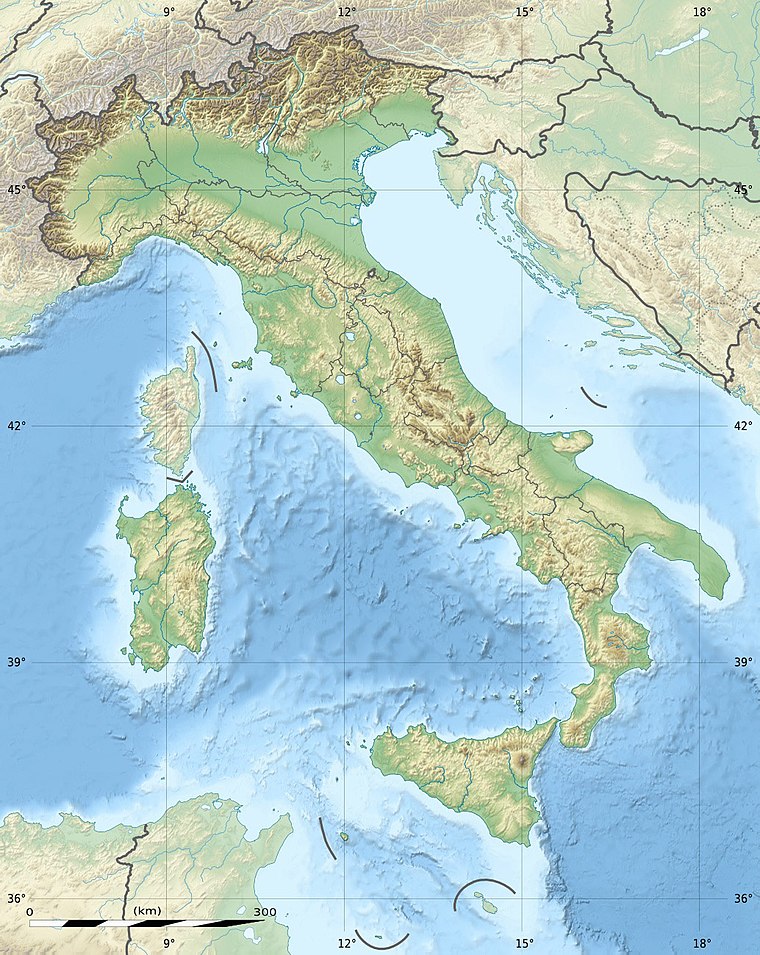|
Alpini
The Alpini are the Italian Army's specialist mountain infantry. Part of the army's infantry corps, the speciality distinguished itself in combat during World War I and World War II. Currently the active Alpini units are organized in two operational brigades, which are subordinate to the Alpine Troops Headquarters. The Alpini's name comes from their inceptive association with the Alps, the mountain range that Italy shares with France, Switzerland, Austria, and Slovenia. An individual soldier of the Alpini is called an Alpino. Established in 1872, the Alpini are the oldest active mountain infantry in the world. Their original mission was to protect Italy's border with France and Austria-Hungary. In 1888 the Alpini deployed on their first mission abroad, in Africa, a continent to which they returned on several occasions and during various wars of the Kingdom of Italy. During World War I they fought a three-year campaign on the Alps against Austro-Hungarian Kaiserjäger and the German Alpenkorps in what has since become known as the "War in snow and ice". During World War II, the Alpini fought alongside the Axis forces primarily in the Balkans Campaigns and on the Eastern Front. During the Cold War the Alpini formed five brigades, which during the 1990s were reduced to two. History1872 to 1887
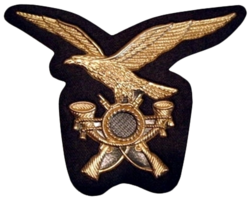 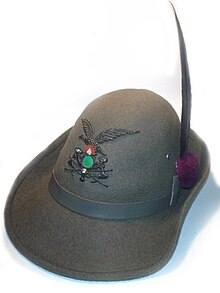 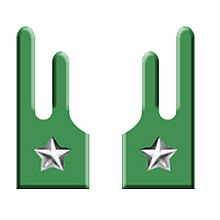  In 1872, Captain Giuseppe Perrucchetti published a study in the May edition of the Military Review (Italian: Rivista Militare). In the study, he proposed to assign the defence of mountain borders of the recently established Kingdom of Italy to soldiers recruited locally. Indeed, thanks to their knowledge of the surroundings and personal attachment to the area, they would be highly capable and better motivated defenders. Perrucchetti drew heavily on the work of Lieutenant General Agostino Ricci, who in 1868 had organised exercises in the mountains to assess the feasibility of a specialised mountain infantry corps. Five months after Perrucchetti's article, the first 15 Alpini companies were formed by Royal decree no. 1056, with their activation effective on October 15, 1872 - the date marked as the official Corps Day. The activation of the mountain companies thus made the Alpini the oldest active Mountain Infantry in the world. At first the Alpini were organized as a militia, capable of defending Italy's northern mountainous borders. Austria's surrender in the Austro-Prussian War of 1866 resulted in Italy annexing the province of Venetia, the northern borders of which coincided in large part with the Alpine Arch. Prior to gaining the new northern borders, homeland defence was based on the so-called Quadrilatero strategy. That outdated strategy, however, ignored the geopolitics of the new Italian Kingdom. It called for primary defence of the Po Valley region ("Pianura Padana") farther to the southwest, but left the Alpine region undefended (as it was considered a territory mainly unsuitable for military operations). Recruiting Italy's mountain valleys locals and organising them into a special corps was indeed an innovative idea. They possessed superior knowledge of mountain territory and greatest adaptability to Alpine conditions. At the beginning, the mountain regions were divided into seven military districts, each commanded by an Officer and home to at least two Alpini companies, each consisting of 120 personnel. Soldiers were equipped with the Vetterli 1870 rifle. In 1873 nine more companies were added, thus totalling 24. In 1875, the companies doubled in size, having 250 soldiers and 5 officers, which were then organised into 7 Alpini battalions. Each battalion was named after one of the seats of the seven military districts:
In 1877, five Alpini mountain artillery batteries were formed and - in the following year - the Alpini had already grown to 36 mountain infantry companies organised into 10 battalions. On November 1, 1882, the Alpini organisation doubled in size to 72 companies and a total of 20 Alpini battalions. The latter plus 8 Alpini mountain artillery batteries were now organized into six numbered Alpini regiments and two Alpini mountain artillery brigades with their respective headquarters and support formations. Each battalion was named after the area it was required to defend in case of war:
The numbers used earlier to distinguish the battalions were dropped while - at the same time - the companies were now numbered from 1 to 72. In order to distinguish the battalions, soldiers and non-commissioned officers were issued thread tufts of various colors (the Nappina), which were added to the Cappello Alpino: white for the First Bn., red for the Second Bn., and Green for the Third Bn. of each regiment. Special Bn. and Fourth Bn. were issued blue tufts. Soldiers of the Mountain Artillery units were issued a green tuft with a black patch in the middle onto which the number of the battery was written in yellow numbers. On June 7, 1883, the green flames (Italian: "fiamme verdi") collar patch was introduced, thus making the Alpini officially a speciality within the Italian infantry corps. The Cappello Alpino, with its black raven feather, was also introduced at that time. The distinctive headdress quickly led the Alpini to be nicknamed "The Black feathers" (Italian: "Le Penne Nere"). Officers hats had the black feather replaced with a white eagle feather. At first, the hat was a black felt hat, but as soon as the new green-grey uniform was adopted in 1909 the hat was changed to the distinctive grey felt still in service today. The Alpini were also distinguished by the green cuffs on the dark blue tunics worn for full dress and barrack dress until 1915, and by green piping on their light blue/grey trousers. When grey-green service uniforms were trialled by the Alpini in 1906, before being adopted by the entire army in 1909, the distinctive green collar patches and typical headdress were retained. The materials, weapons, and equipment of each battalion were stored in the major village of a specific area they were required to defend in case of war. Soldiers of a battalion were only recruited from that area. In 1887, the names of the battalions were changed from those of the defended areas to those of local villages. Therefore, e.g., the Edolo Bn. soldiers were recruited in the vicinity of that village Edolo - where the battalion's arsenal, training ground, and officer's housing were also located. Local recruitment generated strong bonds with and self-identification between the locals and the Alpini units, as men assigned to a single company were all recruited from the same village, and the companies from one valley were all part of the same battalion. In 1887 the Mountain Troops Inspectorate (Italian: Ispettorato delle truppe alpine) was established in Rome, and took administrative command of all Mountain troops. This led to the reorganization of the Alpini Corps: on August 1, 1887, the 7th Alpini Regiment was formed in Conegliano Veneto and assigned two battalions from the 6th regiment. The number of battalions had grown by two, thus reaching 22. On November 1, 1887, the 1st Mountain Artillery Regiment was formed in Turin with nine batteries, each equipped with four 75 mm howitzers. The resulting new layout of the Alpini Corps was as follows:
1888 to 1914Although established as a defensive mountain warfare force, the 1° Battaglione Alpini d'Africa (1st African Alpini Battalion) was established in 1887. The battalion's four companies were composed of volunteers taken from all other Alpini battalions. As part of the Corpo Speciale d'Africa (Special African Corps), the battalion deployed to Eritrea to take revenge for the lost battle of Dogali. The battalion returned on April 27, 1888, to Naples, having lost its commanding officer and 13 men due to tropical diseases. Back in Italy, eight mules were assigned to each Alpini company in the same year. The Vetterli 70 rifle was replaced by the newer Vetterli-Vitali mod. 70/87 rifle. Also, based on a general reorganization of the Italian militia system, 38 Alpini companies and 15 mountain batteries were assigned to active units of the Regio Esercito (Royal Italian Army). In 1892 the Alpini were the first troops to be issued with the new Mod. 91 rifle, which was replaced in 1897 by the Mod. 91TS version and remained in service until 1945. When the tensions between Italy and Abyssinia escalated into the First Italo–Abyssinian War the 1° Battaglione Alpini d'Africa was reformed and sent to Eritrea again. It would soon become the first Alpini unit to engage combat. Four batteries of the 1st Mountain Artillery Regiment were also sent to Eritrea to augment the four deployed brigades under command of Oreste Baratieri. The battalions' first engagement was on March 1, 1896, during the Battle of Adowa. The Alpini were outnumbered and heavily defeated by Abyssinian troops. Over 400 out of 530 men died, including the commanding officer, Lt.Col. Davide Menini. After the battle, the first Gold Medal for Military Valor (Italian: Medaglia d'oro al valor militare) was awarded to a member of the Alpini Corps: Capitan Pietro Cella and his Alpini from the 4th company occupied and held the Amba Rajo (English: Rajo Mountain) until March 2, thus allowing the rest of defeated Italian Army forces to flee. Capitan Cella and all his men died in the effort. In memory of their ultimate sacrifice, he has been awarded the Gold Medal for Military Valor ([1]). After such a defeat, an Alpini expeditionary regiment with 5 battalions was formed and sent to Eritrea on March 7, 1896, but it saw little combat and was repatriated in June of the same year. During the 1900 Boxer Rebellion, a Mountain Artillery Battery was sent to China as part of the international relief force that lifted the siege of the International Compound in Beijing, and remained on garrison duty in Tianjin until the end of 1901. On November 13, 1902, after a short period of experimentation with skis the Alpini began to form specially-equipped and trained Skiing Companies (Italian: Compagnie Sciatori). After a heavy earthquake on September 8, 1905, in the Calabria region (Southern Italy), the Alpini deployed to the area for three months to assist in the clearance of debris and reconstruction efforts. They experienced a similar situation in 1908, after the devastating Messina earthquake. A massive expansion of the Alpini begun in 1909. On July 15 the 2nd Mountain Artillery Regiment was formed in Vicenza with four artillery groups and a total of 12 batteries. In 1908, two new battalions - namely the Tolmezzo and Pallanza (later renamed as Intra in 1909) - had already been formed and assigned to the 7th and 4th regiments, respectively. On October 1, 1909, the "Tolmezzo" and "Gemona" battalions from the 7th Alpini regiment, along with the newly raised Cividale battalion, became the three battalions of new 8th Alpini Regiment, based in Udine. The first commander of the 8th Alpini regiment was Col. Antonio Cantore, who would become a living legend to the Alpini during World War I. As the 8th Alpini regiment was formed, the Alpini could now count on 25 battalions organised into 8 regiments, 2 mountain artillery regiments with 24 batteries organised into 8 groups, and 75 reserve companies organised into 22 battalions. Reserve battalions were named after the valleys from where their soldiers, former Alpini, were recruited (also known as the 'Valle' battalions).
In 1910 the last pre-war Alpini battalion was established as the When Italy declared war on Turkey in 1911 in an attempt to conquer Libya, the Alpini units were once again deployed on desert combat. From 1911 to 1914, the Saluzzo, Mondovì, Ivrea, Verona, Tolmezzo, Feltre, Susa, Vestone, Fenestrelle, and Edolo battalions, together with the Torino-Susa, Mondovì, and Vicenza artillery groups, were deployed to Libya on missions of different duration. The first units to be sent to Libya were the Saluzzo (25 October 1911), Mondovì (3 November 1911), Ivrea (3 November 1911) and Verona (16 December 1911) battalions. When the unexpected Turkish resistance caused an embarrassingly slow advance of the Italian forces, reinforcements were sent to Libya. On October 18, 1912 Turkey and Italy signed the Treaty of Lausanne, which ended the war between the two nations. Italy, however, had now to face a full-scale rebellion by the local population, and required more troops than those deployed in combat to suppress it. Therefore, in October 1912 the Tolmezzo, Feltre, Susa, and Vestone battalions were deployed in Zanzur, Libya, and formed the 8th Special Alpini Regiment (Italian: 8° Reggimento Alpini Speciale) under the command of Colonel Antonio Cantore. The last Alpini unit to leave Libya was the Feltre battalion. It reached Italy in August 1914, while the Bedouin rebellion in Libya continued unabated. World War I 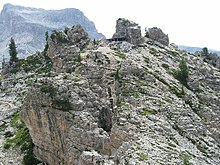 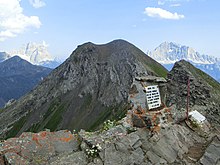 During World War I the 26 peacetime Alpini battalions were increased by 62 battalions and saw heavy combat all over the alpine arch. During the war years the Alpini regiments consisted of the following battalions (the pre-war raised battalions are in bold; their reserve battalions, named after valleys (in Italian: Val or Valle), and the newly raised battalions, named after mountains (in Italian: Monte) drawn from the same recruiting areas as the original battalions follow below the pre-war battalions):
The Alpini battalions fielded 264 companies of one captain, four lieutenants and 250 men each. The Alpini regiments were never sent into battle, but remained at their seats to continue training recruits. The Alpini battalions were grouped together in regiment-sized Groups (Gruppo), and the groups were attached to brigade-sized Groupings (Raggruppamento), which deployed the Alpini battalions as needed. The war, today known as the "War in snow and ice", as most of the 600 km frontline ran through mountains and glaciers of the Alps. 12 meters (40 feet) of snow were a usual occurrence during the winter of 1915/16 and thousands of soldiers were lost in avalanches. The remains of these soldiers are still being uncovered today. The Alpini, as well as their Austrian counterparts: Kaiserschützen, Standschützen and Landeschützen occupied every hill and mountain top around the whole year. Huge underground bases were drilled and dug into the mountainsides and into the ice of glaciers such as the Marmolada. Guns were dragged by hundreds of troops on mountains up to 3,890 m (12,760 feet) high. Roads, cable cars, mountain railroads and walkways were built up, through and along the steepest of cliffs. Many of these walkways and roads are still visible today, and many are maintained as Via Ferrata for climbing enthusiasts. In addition, along the former frontline it is still possible to see what is left of hundreds of kilometers of barbed wire. In this kind of warfare, whoever occupied the higher ground first was almost impossible to dislodge, so both sides turned to drilling tunnels under mountain peaks, filling them up with explosives and then detonated the summits, including its defenders, to pieces: i.e. Col di Lana, Monte Pasubio, Lagazuoi, etc.[10] Climbing and skiing became essential skills for the troops of both sides and soon ski battalions and special climbing units were formed. It was during these years that the Alpini, their spirit and their deeds became famous. Most of the Alpini songs originated during this time and reflect upon the hardships of the "War in Snow and Ice". At the war's end the Alpini counted 114,948 casualties: 14,175 KIA, 61,620 WIA, 39,153 MIA (most lost in avalanches or to mine warfare). World War II
 After World War I all battalions with the exception of the pre-war battalions were dissolved. In 1919 the Alpini gained the 9th Alpini Regiment. In 1935 the fascist government of Italy reorganized its Armed Forces, creating five Alpine divisions and forming a new Alpini regiment: the 11th Alpini Regiment. A 12th Alpini Regiment was also formed to oversee the battalions of the 9th Alpini Regiment, which were not sent with the regimental command and the 5 Alpine Division Pusteria to fight in the Italian attack on Abyssinia. After the return of the 7th Regiment, the 12 Alpini regiment was dissolved. In 1941 the 6th Alpine Division Alpi Graie was raised with reserve units of the other five Alpine divisions. Thus Italy fielded the following six alpine divisions during World War II:
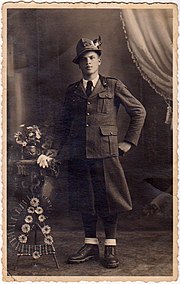  Each division consisted of two Alpini regiments with three battalions each, one Alpine Artillery Regiment with three Artillery groups, one Mixed Engineer Battalion, one Logistic Battalion and some support units. The strength of each division was 573 officers and 16,887 NCOs and soldiers for a total strength of 17,460 men. Also each division had almost 5,000 mules and 500 vehicles of various types at its disposal. 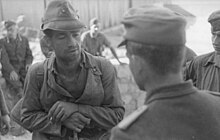 After the Armistice of Cassibile between the Kingdom of Italy and Western Allies became public on 8 September 1943, Italy split in half. The king went to the South of Italy and left the Royal Italian Army without any orders. Subsequently, most divisions of the Army surrendered without a fight to the invading German forces. The only Alpini division to resist the Germans was the 1st Alpine Division "Taurinense", which along with the 19th Infantry Division "Venezia" and remnants of the 155th Infantry Division "Emilia" resisted German attempts to occupy Montenegro. After suffering heavy casualties the divisions troops were given the choice to either surrender or to retreat into the Durmitor mountains and continue the fight. The 16,000 men, who had chosen to fight, formed then the Italian Partisan Division Garibaldi, which entered the II Corps of the Yugoslav Partisans and fought on the Yugoslav Front until it returned to Italy in March 1945. On June 25, 1944, the 3rd Alpini Regiment was recreated in Southern Italy with the battalions Piemonte and Monte Granero. Along with the 4th Bersaglieri Regiment it formed the 1st Italian Brigade of the Italian Liberation Corps, which fought in the war on the Allied side. After the Bersaglieri regiment had suffered heavy casualties the two regiments were merged on 30 September 1944 to form the Special Infantry Regiment, which entered the Legnano Combat Group. The Combat Group was equipped with British weapons and materiel and fought as part of the Polish II Corps on the extreme left of the British 8th Army near the river Idice. In the north a fascist regime under dictator Benito Mussolini, known as the Republic of Salò continued the war alongside the Germans. Its Army, the fascist National Republican Army, raised the 4th Alpine Division "Monterosa", which was trained and equipped by Nazi Germany.[11][12] The division fought along the Gothic Line, notably against units of Brazilian Expeditionary Division, U.S. 92nd Infantry Division and 8th Indian Infantry Division. At the end of the final allied offensive, the division surrendered after the Battle of Collecchio.[13] Cold War 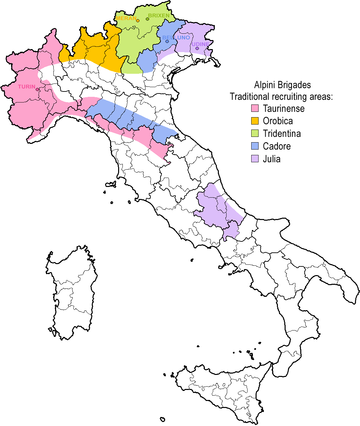 After World War II the Alpini units were once more tasked with defending Italy's northern borders. On 15 October 1949 the Alpine Brigade Julia was activated in Udine; on 1 May 1951 the Alpine Brigade Tridentina was activated in Brixen; on 15 April 1952 the Alpine Brigade Taurinense was activated in Turin; on 1 January 1953 the Alpine Brigade Orobica was activated in Meran and on 1 July 1953 the Alpine Brigade Cadore was activated in Belluno. Each brigade recruited its soldiers from specific parts of the mountainous areas of Italy thus creating a strong bond with the local populations. But only in 1972 when the Taurinense joined the IV Army Corps a singular command was finally in place for all the Alpini, Alpine and Mountain units of the Italian Army. After the 1976 reform the IV Alpine Army Corps was responsible to defend the Italian border along the main chain of the alps from the Swiss-Austrian-Italian border tripoint in the west to the Italian-Yugoslavian border in the east. In case of war with Yugoslavia the IV Alpine Army Corps would remain static in its position guarding the left flank of the Italian V Corps, which would meet the enemy forces in the plains of Friuli-Venezia Giulia. The only brigade which would have seen combat in such a case would have been the Julia. In case of a war with the Warsaw Pact the IV Alpine Army Corps had two war plans: one in the case the Soviet Southern Group of Forces and Hungarian Army would march through Yugoslavia and the other in case the Warsaw Pact would violate the Austrian neutrality and march through Austria. In case the enemy forces would come through Yugoslavia, the Julia would cover the mountainous left flank of the 5th Corps, which with its four armoured and five mechanized brigades would try to wear down the enemy before it could break out into the North Italian Padan plain. The other Alpini brigades would remain static. In the more likely case the Soviet and Hungarian divisions would invade Austria and march through Southern Styria and through the Drava valley in Carinthia the Alpini brigades would have been the first front line units of the Italian Army: the Julia would have defended the Canal valley, the Cadore would have defended the Piave valley and the Tridentina the Puster valley, while the Orobica had a special mission and the Taurinense would remain in reserve. TodayStructure  After the end of the Cold War, all but the Julia and Taurinense Brigades were dissolved, thus leaving the following Alpini units, that still carry the "fiamme verdi" collar insignia:
 Geographical distribution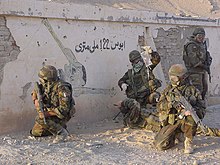  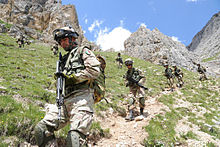 Armament
Currently an Alpino is equipped with a Beretta ARX 160 assault rifle, usually fitted with an Aimpoint M3 Reddot, a Beretta 92 FS pistol, OD/82SE hand grenades, a Type III AP/98 (they are now slowly being provided with the newest NC4/09 bulletproof vest, phasing out the AP/98) bullet-proof vest and a 3rd generation night vision device. The squad automatic weapon is the FN Minimi or, alternatively, the Rheinmetall MG3. Supporting fire can be provided also by M2 Browning (0.50") machine gun, the Hirtenberger M6C-210 Commando 60 mm, man-portable light mortar or by the MO-120-RT-61 120 mm heavy mortar. Mobility is provided by the use of Iveco VTLM Lince 4WD tactical vehicles, Puma 6x6 Armored Personnel Carriers and Bv 206 / Bv 206S all terrain tracked vehicles. The anti-tank weapons are the Panzerfaust 3 rocket propelled grenade and the MILAN 2 and TOW II anti-tank guided missiles. The later two will be replaced by the Spike anti-tank guided missile over the next years. In 1999 the artillery regiments have been issued with the FH-70 howitzer. This has led to a great increase in firepower compared to the previously used OTO Melara Mod 56 pack howitzer, but also reduced their versatility. Indeed, they are not designated now as "mountain artillery", but as "Field Artillery (Mountain)" regiments. Currently the Alpini are being provided with a small number of ARX-160 rifles to field-test the designated standard rifle of the Italian Army in harsh and cold environments. Ranks of the AlpiniThe Alpini share the ranks of the Italian Army but have an additional rank insignia on their Cappello Alpino uniform. All enlisted personnel and junior non-commissioned officers wear no insignia, only officers and senior NCOs wear them and special rank insignia are used by them in the form of chevrons increasing by rank until the rank of Colonel and by silver collar ribbons by general officers. Enlisted and Junior NCOs – No Insignia
Senior NCOs
Junior and Field Officers
General Officers
National Alpini AssociationThe ANA (Associazione Nazionale Alpini or National Alpini Association) is a registered society representing the "Veci" ( ie "the old ones" in English; singular: "vecio" ) or former members of the Alpini corps. As the "Veci" see themselves as merely "on leave" rather than veterans, the ANA is colloquially known to be the 10th Alpini Regiment. Every year since 1920 the ANA has organized a national reunion the "Veci". Hundreds of thousands of Alpini congregate with family and friends in an Italian city for a weekend in the late spring to celebrate and have a good time while remembering old times.[14] Hymn of the Alpini CorpsThe Alpini Hymn L'Inno degli Alpini or Trentatrè - valore Alpino is the official hymn of the Alpini Corps, adapted from an old French mountain song by D'Estel and Travel. As the official anthem of the corps it forms part of the various songs and marches played by the Corps' military bands on parades and concerts, in the latter, the second to the last song to be played before the Italian National Anthem.
[15] Son dell'Alpe i bei cadetti, nella robusta giovinezza Chorus (2x) Sentinella all'erta per il suol nostro italiano II E quando il sole brucia e scalda le cime e le profondità, Repeat Chorus 2x Alpini in Media
See also
References
Sources
External linksWikimedia Commons has media related to Alpini. |
||||||||||||||||||||||||||||||||||||||||||||||||||||||||||||||||||||||||||||||||||||||||||||||||||||||||||||||||||||||||||||||||||||||||||||||||||||||||||||||||||||||||||||||||||||||||||||||||||||

